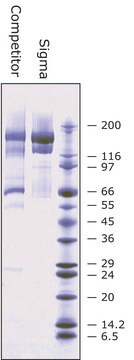M6514
3-(Trimethoxysilyl)propyl methacrylate
≥97%
Sinónimos:
Silane A174, [3-(Methacryloyloxy)propyl]trimethoxysilane
About This Item
Productos recomendados
Ensayo
≥97%
Formulario
liquid
índice de refracción
n20/D 1.431 (lit.)
bp
190 °C (lit.)
densidad
1.045 g/mL at 25 °C (lit.)
temp. de almacenamiento
2-8°C
cadena SMILES
CO[Si](CCCOC(=O)C(C)=C)(OC)OC
InChI
1S/C10H20O5Si/c1-9(2)10(11)15-7-6-8-16(12-3,13-4)14-5/h1,6-8H2,2-5H3
Clave InChI
XDLMVUHYZWKMMD-UHFFFAOYSA-N
¿Está buscando productos similares? Visita Guía de comparación de productos
Descripción general
Aplicación
- Isoelectric focusing can lead to pH gradient formation resulting in the swelling or shrinking of gel casts. This can be prevented by using 3-(Trimethoxysilyl)propyl methacrylate to link polyacrylamide gels to glass plates covalently.
- In situ hybridization using 3-(Trimethoxysilyl)propyl methacrylate along with poly-L-lysine is a faster and durable method to attach cells, microscopic sections, and total organs to slides/other glass surfaces.
- 3-(Trimethoxysilyl)propyl methacrylate is also used in the preparation of organic/inorganic hybrid nanomaterials.
Envase
Producto relacionado
Código de clase de almacenamiento
10 - Combustible liquids
Clase de riesgo para el agua (WGK)
WGK 1
Punto de inflamabilidad (°F)
197.6 °F - closed cup
Punto de inflamabilidad (°C)
92 °C - closed cup
Equipo de protección personal
Eyeshields, Gloves, type ABEK (EN14387) respirator filter
Elija entre una de las versiones más recientes:
¿Ya tiene este producto?
Encuentre la documentación para los productos que ha comprado recientemente en la Biblioteca de documentos.
Los clientes también vieron
Nuestro equipo de científicos tiene experiencia en todas las áreas de investigación: Ciencias de la vida, Ciencia de los materiales, Síntesis química, Cromatografía, Analítica y muchas otras.
Póngase en contacto con el Servicio técnico






![3-[Tris(trimethylsiloxy)silyl]propyl methacrylate contains MEHQ + HQ as stabilizer, 98%](/deepweb/assets/sigmaaldrich/product/structures/148/664/33ff5116-f264-4a64-824a-009c2ca5b2b3/640/33ff5116-f264-4a64-824a-009c2ca5b2b3.png)


